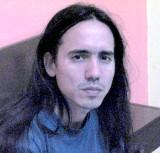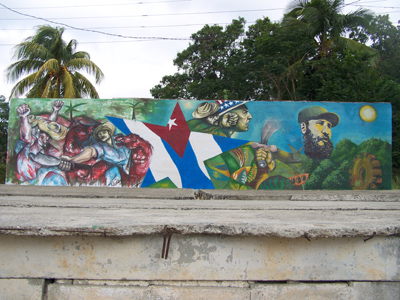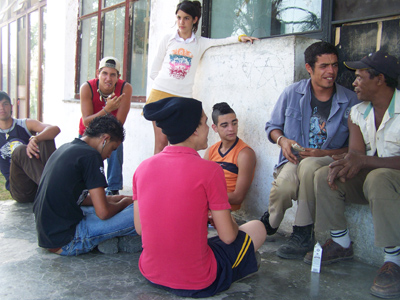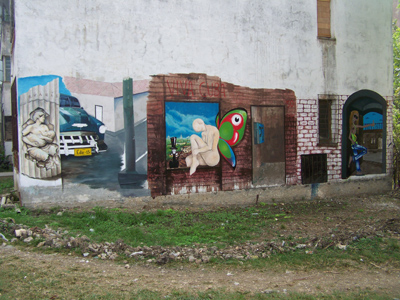Revolution in “El Electrico”

Not long ago, I wrote about the rebirth that was taking place in “El Electrico”, the community in which I live on the outlying south side of Havana. It is far enough away to be free of hustle, bustle and the pollution of the central city
In this conglomeration of apartment buildings -without factories, without sources of income, without a history, without beauty, without worthwhile views; and possessing only monotonous vegetation and debased pop culture- an air of prosperity now blows at the very time a financial crisis shakes the world.

Recently new buses substituted the old “camels” (double-humped tractor-trailers contrived to serve for human transport), and everything seems to indicate that soon we will have telephones and street lighting. Though the problem of electrical service has still not been resolved, there are surprises amid a quarter century of ever-worsening deterioration.
I don’t have the least idea of the magical origin of the money for these improvements, but it seems that the planners have not forgotten the cultural question, at least not in terms of what they understand as being culture; this is clear.
At 33, I can barely hide my first signs of aging. The same thing is happening with these apartment buildings, which were constructed the same decade I was born. Year after year, the paint on my contemporaries has further deteriorated until they now have an eerie appearance. This is worsened by the nocturnal proliferation of graffiti that is sheepishly applied, and which adds nothing more than the wall scribbling on the back streets of US cities.
Not long ago, nothing appeared on Electrico’s horizon in terms of the resources and creativity necessary to halt its apparently inevitable decline. However, a faint hope was rekindled with a program sponsored by the neighborhood authorities.

As if falling from the sky as I began writing this article, Onel appeared at the door of my house. Onel is a good friend, a neighborhood activist who let me recount part of his life in an article that I wrote when I began submitting pieces to this blog.
Onel is an art teacher at the primary school in a community that makes Electrico look like a wealthy suburb. Currently he has been given a leave of absence from his job to work on designing a group of murals that will adorn the sides of buildings in this community. This is why he will be featured in this article as well.

Since he is here with me as I write this article, I will take advantage of his presence to ask him about the inception of this initiative and how they intend to obtain the materials to give a gleam of life and color to the drab Electrico community.
Onel tells me that one of the neighborhood representatives, who is also very young and gets along well with us, had for a quite some time been proposing the idea of covering Electrico with patriotic murals, which would meet the demands of the authorities.

Onel wasn’t too enthused by the idea and every time the neighborhood rep called she was given an unconvincing excuse. This went on until one day he finally accepted the invitation but with the proposal for combining patriotic murals with other ones that openly expressed his creativity.
Now it was the neighborhood rep’s turn to ignore Onel’s proposal, but since no one other than Onel would help him, they both finally met halfway. The neighborhood rep was thinking of painting murals in which Fidel and his concept of revolution would stand out.
She also wanted to highlight the Cuban Five (Cubans imprisoned in the United States on charges of conspiracy to commit espionage), as well as other legendary heroes and epic deeds.
Onel, on the other hand, wanted at all cost to see in paint the extravagant designs circling within his imaginative mind, which would be the delight of the neighborhood hippies.
It was very strange to see these hippies -who are customarily careful to cultivate their image of irreverence and indifference- with paintbrushes in hand under the burning sun. On the wall, they applied colorful paint to fill in the outlines traced by Onel. Among the patterns was the spelling of “REVOLUTION,” designed and executed with the very creativity that is lacked by the revolutionary process here.

The hippies, young adults, my closet friends of the neighborhood, felt their enthusiasm wane when they painted the concept of revolution on the wall. I perfectly understood the ebbing of energy at this point; the concept of revolution elaborated a few years ago by Fidel -although it begins with the sentence, “Revolution is to change all that should be changed”- has become, paradoxically, the favorite refuge of dogmatic, anti-hippie elements.
All this is fine, and I’m very happy that the Electrico shines with the light of Onel; I never imagined anything like that. The only thing lacking for me to be completely happy was that the neighborhood residents were not in any way consulted about what images they wanted to greet them daily.
I have not conducted a survey, but it is quite likely that many of them feel as assaulted by Onel’s demons and other creators as I would have felt had the walls been covered only with eminent figures, patriotic heroes and epic deeds.
After writing this, Onel was approached by several gentlemen of advanced ages, the recalcitrant ones who are so plentiful in our area. They questioned him about painting such an ugly mess (“that doesn’t represent us”) alongside the word “REVOLUTION.” Are you making fun of us,” they asked.
These hardened veterans were encouraging him to somehow redesign what had already been painted. Onel, feeling threatened that his creatures could be whitewashed or otherwise undermined, felt as upset as if these were his very own loved ones.






Wow, I cannot believe what I am seeing! My cousin and aunt live/ used to live in that building. When I was about 5 years old I remember dropping una piedra de la Caridad del Cobre in the trail shown in the picture titled “Other creators had the opportunity to contribute.” I left my heart in Cuba in 1995 and haven’t seen my family since 2001. Castro has destroyed so much more than the small town shown in these pictures, he has torn apart families.
Esa vista (The street I’ve lived on since I was born) parece ser más o menos del edificio 40, por allá atrás se ve el edificio 55, el 36, etc. Ese Reparto Electrico está en llamas, no hay por donde agarrarlo. El día que salgas de ahí se te abrirán otras puertas. No tomes lo que te digo por cualquier cosa, es muy en serio. Ese lugar deprime. El infierno dentro del infierno, una mierda de lugar, como tantos otros en Cuba. Un cosa es vivir en un lugar lejano y otra cosa es vivir en un lugar lejano, abandonado y muerto en todo sentido.
Cambiando de tema. Se puede ser loco, filósofo, original, genio pero recuerda que la vida es una sola y la tuya la veo enyerbada. Va y me equivoco. ¿Te sientes feliz? Si lo eres, ok great. Si no lo eres te recomiendo que rebobines la cinta y te concentres para que salgas del hueco. Lo único que te quiero evitar es que después de una tonga de años escribiendo en este sitio web, lo único que tengas de vida sea el tramo Reparto Eléctrico-Centro de trabajo-Reparto Eléctrico.
Es muy triste mirar atrás y reconocer que uno vivió mareado. Los viejos ya no tienen remedio, pero los jóvenes están advertidos.
Ojalá sea yo trivial, sino piensa un poco en lo que te digo.
Suerte.